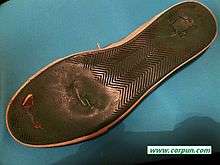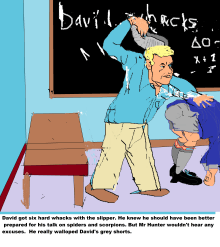Slippering
| Part of a series on |
| Corporal punishment |
|---|
 |
| By place |
| By implementation |
| By country |
| Court cases |
| Politics |
A slippering is a term for the act of smacking the buttocks, or the hands, with a slipper as a form of corporal punishment. A slippering on the buttocks is a form of spanking; it is a much more common method than slippering on the hands. The verb "to slipper" means "to give a slippering". Until at least the 1970s slippering was widely used by British parents as a means of punishing children and adolescents. The routine nature of such punishment is demonstrated by the frequency with which comics of the day (e.g. The Beano and The Dandy) showed scenes in which characters such as Dennis the Menace, Roger the Dodger, Minnie the Minx and Beryl the Peril were slippered by an irate parent. In a typical scene the child is placed across the parent's lap or bent over the end of a sofa and the sole of the slipper is applied vigorously and repeatedly to the seat of the child's trousers or skirt. Such scenes presumably represented day-to-day reality for thousands of British children. However, in real life it is probable that many children fared rather worse than Dennis and his friends inasmuch as they were punished on the bare bottom, either lying across the parent's lap or (especially in the case of teenagers) bending over an item of furniture. While slipperings are no longer depicted in comics, the practice no doubt continues in many British families but is much less common than in former times.
There are very little data, research or evidence about the use of slippering. Information is mainly based on anecdotal reports from individuals who have given, received, or observed slipperings, or who have been in households or schools where slipperings were used. Slipperings are particularly associated with Britain and Commonwealth countries, although not exclusively so.
School slippering

In the United Kingdom, especially in England and Wales, the slipper was a common implement for administering corporal punishment in schools for students of both genders and all ages. In schools that used the cane as the ultimate penalty, the slipper was seen as a less severe alternative for punishing less serious misconduct. In some mixed schools the slipper was used on girls and the cane was reserved for boys. "Slipper" is a misnomer, as the usual item of footwear used was the plimsoll, or gymshoe or tennis shoe, with a fabric upper and a heavy rubber or synthetic sole. This could deliver a very painful stroke, depending on the force with which it was used, and the size and flexibility of the particular slipper; a size 11, well-worn, flexible slipper would deliver more sting than one that was new and stiff. Though not a slipper in the usual sense of the term, the implement used was invariably referred to as "the slipper" by teachers and pupils alike, presumably on account of its similarity to the type of carpet slipper used for parental punishments.

A typical gym shoe, which was actually used in a school in Lincolnshire, is shown on the left.
At many schools, students who committed minor classroom offences — talking or disruption, for example — could be punished there and then in the classroom by the class teacher. Typically this would involve two or three quick, sharp swats across the seat of the offender's trousers (or skirt), with the student either bending over the teacher's desk, or standing and bending forward with hands on knees, or bending right down and touching toes. Generally the teacher was free to determine which position the pupil had to adopt. This method of punishment also served to demonstrate to the class that such behaviour would not be tolerated. Immediately after being punished, the student, closely watched by his classmates, would have to stand up, turn round and go back to his place and sit down, adding to the embarrassment and pain, both of which were seen as part of the deterrent to further misbehaviour.
The slipper was also widely used to enforce discipline outside lesson time within the boarding houses of boarding schools, especially preparatory schools for younger boys. Slipperings were commonly administered by the boarding house Matron, who was responsible not only for the welfare of the boys, but also for maintaining order in the dormitories. "Talking after lights out" was a common reason for a visit to Matron's study for the slipper, which was willingly accepted as an alternative to being sent to the headmaster for the cane.
This "informal", on-the-spot type of discipline was typically not recorded in the official punishment register, as it was not seen as sufficiently serious to be classified as real corporal punishment. Also, it could be administered by staff who were not officially authorised to administer formal corporal punishment, so were not allowed to use the cane. In fact, though, it could sometimes be just as painful as the officially recorded punishment.
A minority of schools also designated the slipper as their official punishment implement instead of the cane, for more serious misbehaviour, especially infractions committed outside the classroom, such as smoking. In this case, slipperings were carried out as a formal ceremony in the same way as canings at other schools, i.e. the student would be summoned to the private office of the Head Teacher (principal) or Deputy Head or of a senior teacher of the same gender as the student. The student would typically be interviewed about his offence before being told his punishment. He was then required to remove his blazer, empty his back pockets and bend over a desk or chair. Up to six powerful strokes of the slipper would then be delivered in a solemn, measured manner to the seat of the trousers. This would be recorded in the school's punishment book.
This more severe kind of slippering would typically leave the student's buttocks lightly bruised for a few days, providing a further reminder each time he sat down. However, there was no danger of superficial bleeding as there could be with a caning.
An example of a school that opted for the slipper as its formal disciplinary implement was Litherland High School in Liverpool, a mixed-sex school, although the policy there was that only boys could receive corporal discipline. The school recorded more than 1,800 official slipperings in 1980.[1] Another school where the slipper was in regular use was King's School, Macclesfield. At that boys' grammar school in Cheshire slipperings were administered in the classroom in a solemn, formal atmosphere. Boys aged between 11 and 16 were required to bend over and received up to 12 hard whacks on the seat of the trousers. The punishment, which was extremely painful, was the standard response to a wide variety of disciplinary offences, including failing end-of-term tests. The cartoon on the right shows a boy being slippered at King's School in the 1960s. (http://www.corpun.com/kettering.htm)

More typical, in that the cane was the "official" punishment, and slippering routinely used more informally, was Highbury Grove School, a large boys' school in north London.[2]
All forms of corporal punishment were banned in state schools in the UK in 1987. A ban in private schools followed in England and Wales (1999), Scotland (2000), and Northern Ireland (2003). There are frequently calls for it to be reinstated, with most polls in the media still showing the majority of the UK public in favour of its use in schools.
References
- ↑ "Staffroom mole leaks secret of his school's beatings book", Daily Mail, London, 24 January 1981 (includes pictures of two slippered boys).
- ↑ "Caning for "slap happy" school", Islington Gazette, 26 May 1978 (includes picture of slippered boy).
External links
- Overview of corporal punishment in British schools at World Corporal Punishment Research